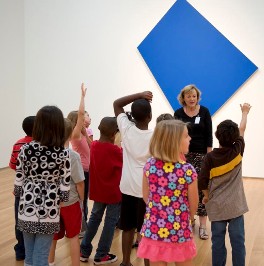On Tour (Story)
Cathy Bradley, NCMA Docent and former Wake County Schools educator
Several weeks ago, I gave a tour to a group of middle-school aged home-school students and their chaperones. They were visiting the museum to hear a docent explain what we do and why we do it. I began by giving them some background about myself and the docent organization, and then I offered them an opportunity to ask me questions. Not long into the conversation, I could see that they were very well-prepared and excited about their visit, so I decided to be bold. My approach was going to be to use six to eight works of art as a vehicle for discussing how and why we look at art and just what is it? Also, how does having a docent-led tour change the experience?
We started out at Ellsworth Kelly’s Blue Panel, in front of which the group stood solemnly for a few minutes before offering comments about what it reminded them of and whether or not they thought it belonged in a museum….they were skeptical. We talked about who makes these decisions, and what curators do. Next, we moved on to Portrait of Emy, and one student asked right away if the artist was influenced by Picasso, while another said her face looked like a mask, so we talked about these points as well as Schmidt-Rottluff’s use of color and line, what Expressionism was, and what “abstract” really means. The students wanted to know if I had to learn several languages to be a docent, or if I had to have training in public speaking. On the first point, I shared that I regretted not learning more foreign language, and that art scholars often did study several. As for public speaking, I used to teach theatre, and I told them I thought docents enjoyed talking with the public and were pretty good at it. Shifting back to art, I wanted to show them Michael Richard’s Tar Baby vs. Saint Sebastian, and they again shared very mature insights, though I think other works might have been more effective for this age group.
I asked if they wanted to continue in contemporary art, but they asked to see some medieval and Renaissance pieces, so we moved on to a series of Madonna and Child paintings – Berlinghieri, Cima, and Reni because they asked some questions about how paint had changed over time and how artists responded to these changes. This was certainly an unusual question for students their age, but we talked quite a bit about the changes in paint and the depiction of the human figure over several centuries. Their comments led me to think we should touch on conservation, and since we had started with a very abstract work, I wanted to finish with a painting with a strong narrative, so we went to visit Sir William Pepperrell (1746-1816) and His Family. We spent time uncovering the story in the work, and they had a number of questions about how works were restored as well as some of the conventions of eighteenth century portraits.
By this time, our tour was well over an hour long, but it was such a rewarding experience for me, and I hope, for these students. If you are a docent, the next time you are called upon to give a tour, think about approaching it from the perspective of what we do that enriches the visitor’s experience, what we help them see that they might not perceive on their own. If you are that visitor, ask your docent questions that you think only she might know. Think of your docent as a guide who will help you remember the works of art you see for a very long time.

